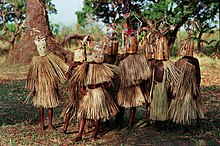
Back حدية (علم الإنسان) Arabic Liminalitat Catalan Liminalfase Danish Liminalität German Liminalidad Spanish Liminarité French לימינליות HE Liminalitas ID リミナリティ Japanese 리미널리티 Korean

| Part of a series on |
| Anthropology of religion |
|---|
 |
| Social and cultural anthropology |
In anthropology, liminality (from Latin limen 'a threshold')[1] is the quality of ambiguity or disorientation that occurs in the middle stage of a rite of passage, when participants no longer hold their pre-ritual status but have not yet begun the transition to the status they will hold when the rite is complete.[2] During a rite's liminal stage, participants "stand at the threshold"[3] between their previous way of structuring their identity, time, or community, and a new way (which completing the rite establishes).
The concept of liminality was first developed in the early twentieth century by folklorist Arnold van Gennep and later taken up by Victor Turner.[4] More recently, usage of the term has broadened to describe political and cultural change as well as rites.[5][6] During liminal periods of all kinds, social hierarchies may be reversed or temporarily dissolved, continuity of tradition may become uncertain, and future outcomes once taken for granted may be thrown into doubt.[7] The dissolution of order during liminality creates a fluid, malleable situation that enables new institutions and customs to become established.[8] The term has also passed into popular usage and has been expanded to include liminoid experiences that are more relevant to post-industrial society.[9]
- ^ "liminal", Oxford English Dictionary. Ed. J. A. Simpson and E. S. C. Weiner. 2nd ed. Oxford: Clarendon Press, 1989. OED Online Oxford 23, 2007; cf. subliminal.
- ^ Cite error: The named reference
:0was invoked but never defined (see the help page). - ^ Guribye, Eugene; Lie, Birgit; Overland, Gwynyth, eds. (2014). Nordic Work with Traumatised Refugees: Do We Really Care. Cambridge Scholars Publishing. p. 194. ISBN 978-1-4438-6777-1.
- ^ "Liminality and Communitas", in "The Ritual Process: Structure and Anti-Structure" (New Brunswick: Aldine Transaction Press, 2008).
- ^ Katznelson, Ira (11 May 2021). "Measuring Liberalism, Confronting Evil: A Retrospective". Annual Review of Political Science. 24 (1): 1–19. doi:10.1146/annurev-polisci-042219-030219.
- ^ Thomassen, Bjørn (2009). "The Uses and Meanings of Liminality". International Political Anthropology. 2 (1): 5–27.
- ^ Horvath, A.; Thomassen, B.; Wydra, H. (2009). "Introduction: Liminality and Cultures of Change". International Political Anthropology. 2 (1): 3–4.
- ^ Szakolczai, A. (2009). "Liminality and Experience: Structuring transitory situations and transformative events". International Political Anthropology. 2 (1): 141–172.
- ^ Barfield, Thomas (1997). The Dictionary of Anthropology. p. 477.